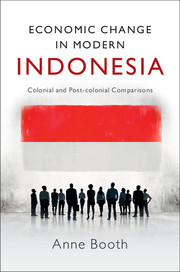Book contents
- Frontmatter
- Contents
- List of tables
- Acknowledgements
- 1 Introduction: Indonesia's three watersheds
- 2 The colonial legacy
- 3 Occupation, liberation and the challenges facing the new republic, 1942–66
- 4 Suharto's economic record: successes and failures
- 5 The 1997–98 crisis and its legacy: dropping out again?
- 6 The SBY years: building a new Indonesia?
- 7 Economic nationalism, economic rationalism and the development of private business after 1950
- 8 Trends in poverty and income distribution: the Suharto era and beyond
- 9 The changing role of government from the colonial era to the post-Suharto years
- 10 Conclusions
- Bibliography
- Index
8 - Trends in poverty and income distribution: the Suharto era and beyond
Published online by Cambridge University Press: 05 February 2016
- Frontmatter
- Contents
- List of tables
- Acknowledgements
- 1 Introduction: Indonesia's three watersheds
- 2 The colonial legacy
- 3 Occupation, liberation and the challenges facing the new republic, 1942–66
- 4 Suharto's economic record: successes and failures
- 5 The 1997–98 crisis and its legacy: dropping out again?
- 6 The SBY years: building a new Indonesia?
- 7 Economic nationalism, economic rationalism and the development of private business after 1950
- 8 Trends in poverty and income distribution: the Suharto era and beyond
- 9 The changing role of government from the colonial era to the post-Suharto years
- 10 Conclusions
- Bibliography
- Index
Summary
Estimates of poverty and income distribution after 1965
In Chapter 3, it was argued that there was considerable evidence that poverty and malnutrition were widespread in Indonesia by the mid-1960s, although the Sukarno government appeared to be in denial about the problem. The Indonesian Communist Party had drawn support from both the rural landless and employees in the estates sector and in the urban economy, but had no clear strategy for improving living standards beyond redistribution of land. The party supported the occupation of former estate land in parts of Java, but most Indonesians, even those on the left, realised that there was insufficient land in Java to give all rural households even one hectare, let alone the two hectares which the 1960 Basic Agrarian Law stipulated should be the minimum holding size. When pressed about the problem of ‘too many people and not enough land’, Sukarno and his ministers tended to fall back on the old colonial solution of moving people from Java, Bali and the eastern islands to the supposedly ‘empty lands’ in Sumatra, Kalimantan, Sulawesi and the newly acquired West Irian, later to become Irian Jaya, and now the two provinces of Papua and Papua Barat.
After power was wrested from Sukarno in 1966, economic policy was concerned primarily with macroeconomic problems. It was expected that a reduction in inflation and a return to growth would alleviate the problem of poverty, and lead to a general improvement in living standards. The first Five Year Plan of the Suharto era placed most attention on the agricultural sector, especially on increasing rice production. The Plan also stressed the need to rehabilitate and extend rural infrastructure, especially roads and irrigation. But it was criticised for its neglect of non-rice food crops, including both corn and cassava, as well as soybean and vegetables, which are important sources of protein and vitamins for the poor. By the early 1970s, some academic commentators, worried about the evidence of widespread and persistent poverty and malnutrition in Indonesia, were arguing that economic growth alone would not be sufficient to reduce poverty in Indonesia.
At this time there was a growing international debate over ‘redistribution with growth’ encouraged by the World Bank, the International Labour Organization and by a number of well-known academics in various parts of the world.
- Type
- Chapter
- Information
- Economic Change in Modern IndonesiaColonial and Post-colonial Comparisons, pp. 157 - 198Publisher: Cambridge University PressPrint publication year: 2016



